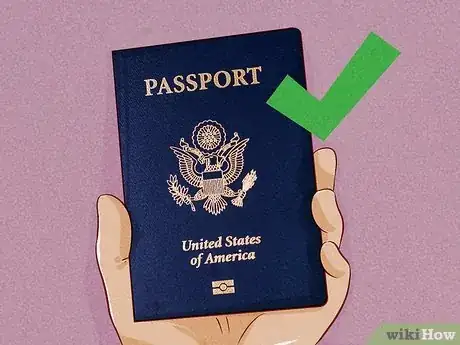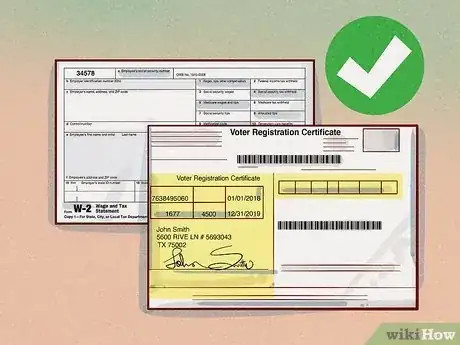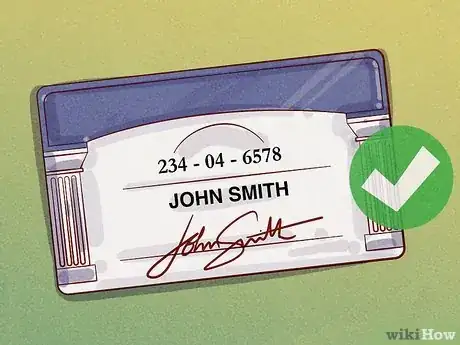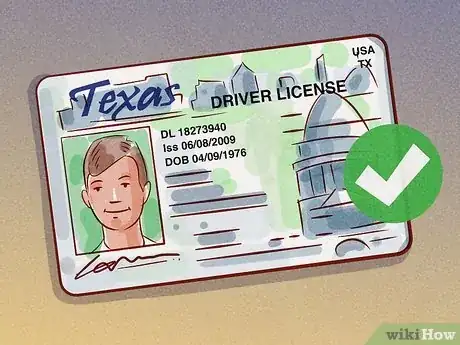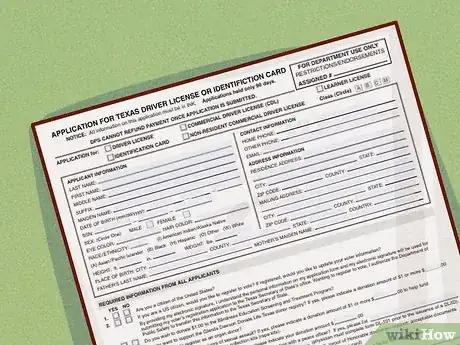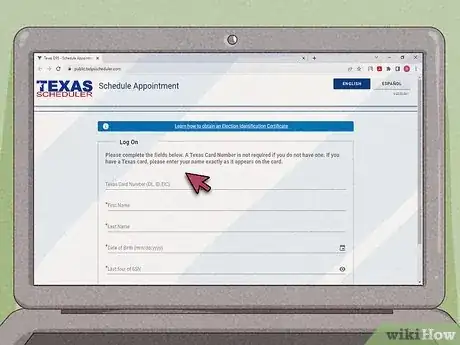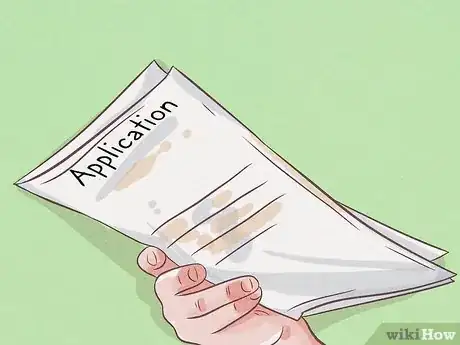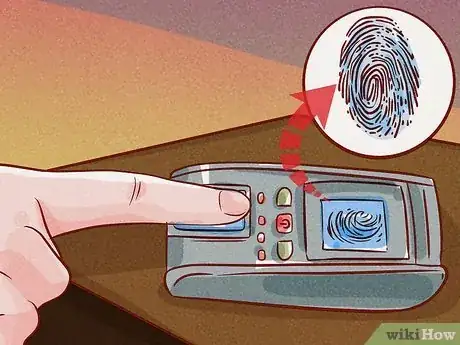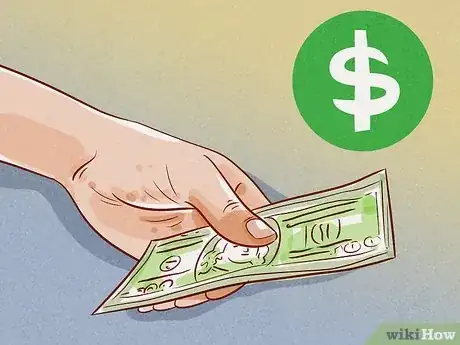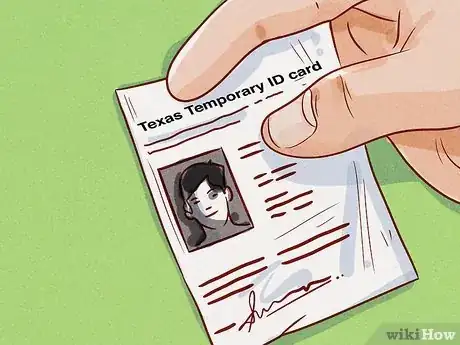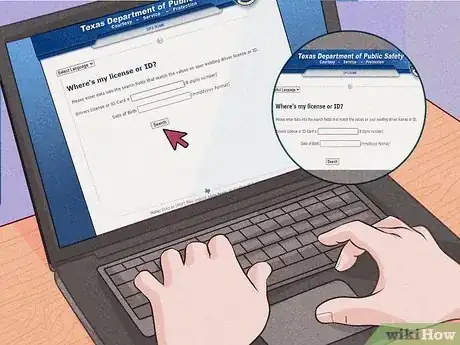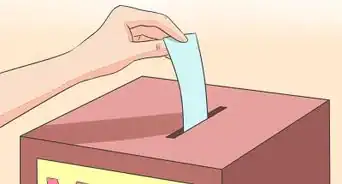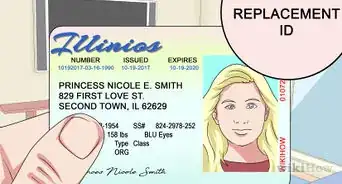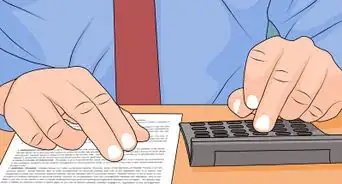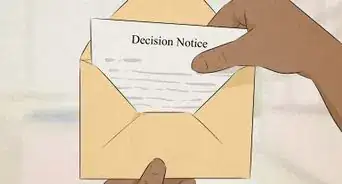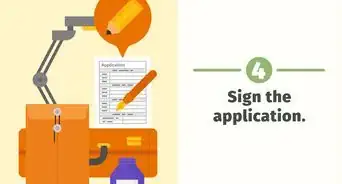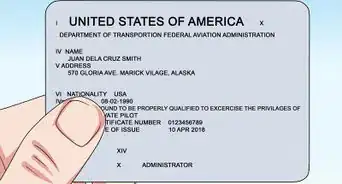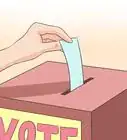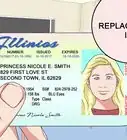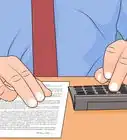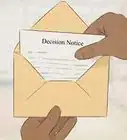This article was co-authored by wikiHow staff writer, Jennifer Mueller, JD. Jennifer Mueller is an in-house legal expert at wikiHow. Jennifer reviews, fact-checks, and evaluates wikiHow's legal content to ensure thoroughness and accuracy. She received her JD from Indiana University Maurer School of Law in 2006.
There are 7 references cited in this article, which can be found at the bottom of the page.
This article has been viewed 121,606 times.
Learn more...
Have you recently moved to Texas and need a state ID? Even if you don't drive, an official state ID helps prove your identity so you can easily vote, buy alcohol, or fly on a plane. Just make sure you do this well in advance of the date you might need it—it can take up to 6 weeks to get the actual ID after you submit your application.[1] Read on to find out everything you need to know to get your ID, including what specific documents you need to bring with you.
Things You Should Know
- Bring original documents to prove your US citizenship or lawful presence, Texas residency, identity, and Social Security number.
- Download, print, and fill out the application before you go to the Driver License Office to apply.
- Make an appointment to apply in person at your local Driver License Office.
- Be prepared to wait 4-6 weeks for your official ID to arrive in the mail.
Steps
Required Documents
-
1Bring 1 original document that shows your US citizenship status. If you're a US citizen, you can prove your citizenship with either a valid, unexpired passport or an original US birth certificate. If you are not a US citizen, use at least one of the following documents to prove your lawful presence in the US:[2]
- A valid, unexpired Permanent Resident Card (Form I-551)
- A machine-readable Immigrant Visa with temporary I-551 language and ADIT stamp
- A valid, unexpired foreign passport, visa (either valid or expired), and valid I-94
- A valid, unexpired employment authorization document (EAD, Form I-766)
-
2Gather 2 original documents with your name and address on them. You have to live in Texas for at least 30 days before you're eligible for a state ID, although you can skip this waiting period if you give them your valid driver's license or state ID from another state. Bring at least 2 original documents from the following list to prove your Texas residency:[3]
- Current deed, mortgage, mortgage statement, or residential rental/lease agreement
- Valid, unexpired Texas voter registration card
- Valid, unexpired Texas motor vehicle registration or title
- Valid, unexpired Texas boat registration or title
- Valid, unexpired Texas concealed handgun license (CHL) or license to carry (LTC)
- Utility bill (such as an electric, water, or cell phone bill) with your name and address on it dated within 90 days of the date of your appointment
- Selective service card
- Current homeowner's or renter's insurance policy, statement, or card
- Texas high school, college, or university report card or transcript for the current school year
- Preprinted tax or financial statements from an employer, government, or financial institution, including pay stubs
- Current Form DS2019 or other document issued by US Citizenship and Immigration Services (USCIS)
Advertisement -
3Find your Social Security card or order a new one. Texas law requires you to have a Social Security number to get a Texas ID. Your original Social Security card is proof of that. If you don't have your Social Security card, go ahead and get one before you apply for a Texas ID. You won't need to show it if your Social Security number is already in the system, but if you're not sure if it is, it's better not to risk it.[4]
- If you need to apply for your ID in a hurry and don't have time to wait for a Social Security card, see if you have a W-2, SSA-1099 form, or pay stub with your Social Security number on it. Those will work to verify your number.
-
4Get either 1 primary identity document or 2 secondary identity documents. The easiest way to prove your identity is with a single identity document from the primary list. If you don't have one of those, you can use 2 documents on the secondary list. If you don't have 2 documents on the secondary list, you need at least 1 from the secondary list and 2 from the supporting list.[5]
- Primary identity documents: US passport, Texas driver license or ID card not expired for more than 2 years, US certificate of citizenship or naturalization, USCIS document with verifiable information and photo, valid foreign passport with attached visa, unexpired US military ID card
- Secondary identity documents: original or certified copy of a US birth certificate, original or certified copy of a court order for a name or gender change, other birth documents issued by a state or local government
- Supporting identity documents (at least 2): Social Security card, Form W-2 or 1099, driver license or ID card issued by another US state or territory, others (see https://www.dps.texas.gov/section/driver-license/identification-requirements for the full list)
- If you're using a name that's different from the one on your birth certificate, you also need a document that shows proof that your name was legally changed, such as a marriage certificate or a court order.
Submitting Your Application
-
1Download and complete your application online. Go to https://www.dps.texas.gov/internetforms/Forms/DL-14A.pdf to access the application. Type your answers into the form, then print it out to take with you to the Driver License office.[6]
- Do not sign the form after you print it out. Wait until the license and permit specialist at the Driver License Office tells you to sign it.
-
2Make an appointment at your local Driver License Office. The Driver License Office offers ID card services by appointment only. As a first-time applicant, you have to apply in person, so go to https://public.txdpsscheduler.com/ to schedule your appointment. If you're renewing, you can do that completely online.[7]
- If you don't see the closest office to you listed when you go to schedule an appointment online, that means that office doesn't have any available appointments. Try the one next closest to you and see if they have anything.
-
3Give your application and documents to the license and permit specialist. The specialist will put the information from your application into the computer and verify your documents. This might take a few minutes—if they have any questions, they'll let you know.[8]
- If you've got all of the original documents on the list, you should be fine. Just answer any questions from the specialist honestly. If something you brought isn't acceptable, they'll tell you what you need to do.
-
4Provide your signature and digital thumbprints. The specialist will get you to sign the signature block on your application—this is the signature that will appear on your ID card. Then, they'll take digital thumbprints as an additional step to protect your identity.[9]
-
5Take your ID photo. The specialist will direct you to a photo area to take your photo. Typically, they'll tell you to use a neutral facial expression—just a blank face, not a smile.[10]
- Don't worry too much about how your ID photo looks. It's totally normal for this to not be the best picture ever taken of you.
-
6Pay the application fee. As of 2022, the fee for an ID card is $16 if you're 59 or younger. If you're 60 or older, the fee is only $6. You can pay your fee using cash, personal check, money order, or credit card.[11]
- Your ID is valid for 6 years and expires on your birthday. When you renew, you'll pay the same fee.
-
7Check your temporary ID for mistakes. Once you pay your fee, the specialist will issue your ID and print out a temporary copy for you to use until you get the official card in the mail. Read the information on the card carefully and make sure it's all correct. [12]
- If something's wrong, let the specialist know so they can correct it immediately before your card is made.
-
8Wait 4-6 weeks for your official card to arrive in the mail. Unfortunately, there's no way to expedite this process, so plan ahead if you need your ID for a specific purpose. Most places will accept your temporary ID with no problems in the meantime.[13]
- If you're getting antsy, go to https://www.dps.texas.gov/DriverLicense/DLSearch/DLStatus.aspx and enter the number on your temporary card to check the status.
Community Q&A
-
QuestionIs a parent required to accompany an 18-year-old to obtain their ID card?
 wikiHow Staff EditorThis answer was written by one of our trained team of researchers who validated it for accuracy and comprehensiveness.
wikiHow Staff EditorThis answer was written by one of our trained team of researchers who validated it for accuracy and comprehensiveness.
Staff Answer wikiHow Staff EditorStaff AnswerNo, an 18-year-old is a legal adult. A parent isn't required to accompany anyone under 18, either.
wikiHow Staff EditorStaff AnswerNo, an 18-year-old is a legal adult. A parent isn't required to accompany anyone under 18, either. -
QuestionAm I able to submit the completed "TEXAS DRIVER LICENSE OR IDENTIFICATION CARD APPLICATION" online in El Paso, Texas, or do I have to take it in to the Motor Vehicle Department?
 wikiHow Staff EditorThis answer was written by one of our trained team of researchers who validated it for accuracy and comprehensiveness.
wikiHow Staff EditorThis answer was written by one of our trained team of researchers who validated it for accuracy and comprehensiveness.
Staff Answer wikiHow Staff EditorStaff AnswerTexas does not accept online applications anywhere in the state if it's your first time getting an ID. You have to take the completed application with you to your appointment at the Driver License Office so they can take your photo and fingerprints and witness your signature on the application.
wikiHow Staff EditorStaff AnswerTexas does not accept online applications anywhere in the state if it's your first time getting an ID. You have to take the completed application with you to your appointment at the Driver License Office so they can take your photo and fingerprints and witness your signature on the application. -
QuestionI need an ID card for air travel. Can I get it faster? I need it in about 10 days.
 wikiHow Staff EditorThis answer was written by one of our trained team of researchers who validated it for accuracy and comprehensiveness.
wikiHow Staff EditorThis answer was written by one of our trained team of researchers who validated it for accuracy and comprehensiveness.
Staff Answer wikiHow Staff EditorStaff AnswerUnfortunately, there's no way to speed up the process of getting your official ID card. Your temporary card should work, although you might want to also bring along another form of identification to back it up. It'll be fine within the state of Texas, but you might run into problems outside the state simply because security personnel aren't familiar with the Texas temporary ID and don't know how to verify it.
wikiHow Staff EditorStaff AnswerUnfortunately, there's no way to speed up the process of getting your official ID card. Your temporary card should work, although you might want to also bring along another form of identification to back it up. It'll be fine within the state of Texas, but you might run into problems outside the state simply because security personnel aren't familiar with the Texas temporary ID and don't know how to verify it.
References
- ↑ https://www.dps.texas.gov/section/driver-license/how-apply-texas-identification-card
- ↑ https://www.dps.texas.gov/section/driver-license/us-citizenship-or-lawful-presence-requirement
- ↑ https://www.dps.texas.gov/section/driver-license/texas-residency-requirement-driver-licenses-and-id-cards
- ↑ https://www.dps.texas.gov/section/driver-license/social-security-number-ssn
- ↑ https://www.dps.texas.gov/section/driver-license/identification-requirements
- ↑ https://www.dps.texas.gov/section/driver-license/how-apply-texas-identification-card
- ↑ https://www.dps.texas.gov/section/driver-license/driver-license-services-appointments
- ↑ https://www.dps.texas.gov/section/driver-license/how-apply-texas-identification-card
- ↑ https://www.dps.texas.gov/section/driver-license/how-apply-texas-identification-card
- ↑ https://www.dps.texas.gov/section/driver-license/how-apply-texas-identification-card
- ↑ https://www.dps.texas.gov/section/driver-license/driver-license-fees
- ↑ https://www.dps.texas.gov/section/driver-license/how-apply-texas-identification-card
- ↑ https://www.dps.texas.gov/section/driver-license/how-apply-texas-identification-card
- ↑ https://www.dps.texas.gov/section/driver-license/how-apply-texas-identification-card
- ↑ https://www.dps.texas.gov/section/driver-license/texas-residency-requirement-driver-licenses-and-id-cards
